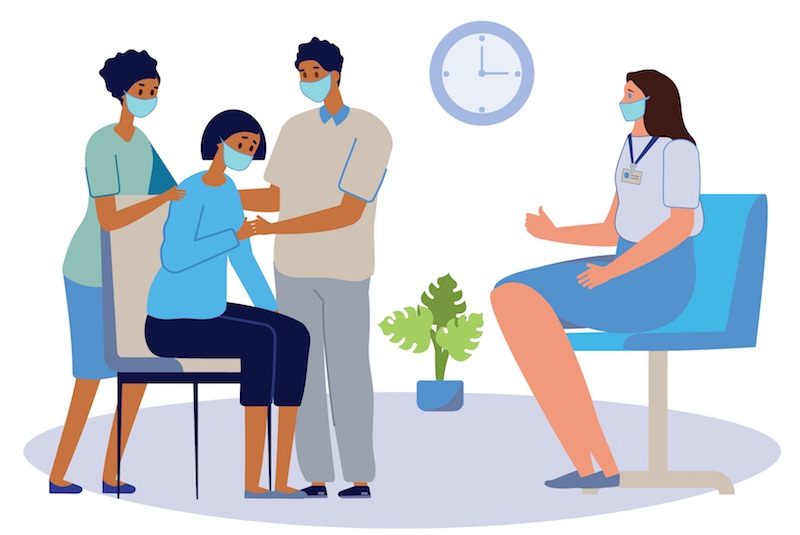Suicide prevention in teens: Can we intervene through primary care?

The past year has seen a disturbing rise in suicidal thoughts and attempts among adolescents, with a spike of suicidal teens going to emergency departments (EDs). This adds to a growing trend: From 2007 to 2016, ED visits for deliberate self-harm more than quadrupled nationwide among children age 5 to 17.
In a recent review co-led by Boston Children’s Hospital, suicide-related hospitalizations held steady during the first six months of COVID-19, even as admissions fell for nearly all other causes. Suicidal adolescents are also waiting longer in the ED, where they may “board,” sometimes for days, until a psychiatric bed opens up.
But what if they could receive a brief suicide prevention intervention in the ED and be sent home safely? And what if they could be treated in primary care, without the need for ED visits at all?
Tools for patients and families
About 20 years ago, Elizabeth Wharff, PhD, MSW, then the director of Emergency Psychiatry at Boston Children’s, developed the Family-Based Crisis Intervention (FBCI). The 90-minute intervention stabilizes suicidal adolescents and gives them and their families training and tools to safely manage crises at home.
“It was revolutionary then to try to do mental health treatment in the ED,” says Wharff. “It was assumed that kids would go to an inpatient psychiatry unit. Even today, there is no regular kind of treatment given to patients waiting for beds. But EDs are starting to come around.”
FBCI combines safety planning with cognitive-behavioral skill building and psychoeducation to help teens understand and manage their feelings. But its cornerstone is the Unified Crisis Narrative, in which the adolescent and family create a shared narrative of the events precipitating the suicidal thoughts or attempt.
“Poor family communication has been associated with suicidal ideation,” says Abigail Ross, MSW, MPH, PhD, who was part of the development of FBCI. “Many kids think their parents won’t understand them or will be mad at them.”
A shared crisis narrative
In a sample crisis scenario, a teen girl swallows a bottle of pills after being dumped by her boyfriend and virtually abandoned by her friends. She hasn’t told her parents, believing they don’t like the boyfriend or the friends. Her parents had known nothing of this or the distress it caused, but noticed that their daughter had started smoking.
In creating a shared narrative, the girl and her parents come to realize how they’ve misinterpreted each other’s words and actions.
“It’s often very emotional,” says Wharff. “Kids and parents finally feel understood by the other. That reduces suicidality. Kids no longer feel hopeless, and they feel like they have their parents on board.”
“Most evidence-based treatments for suicide risk don’t involve the parents, except during safety planning,” adds Ross. “The family work to improve communication and create a shared crisis narrative is what sets FBCI apart.”
Testing FBCI in the ED
FBCI’s core assumptions
1) Crisis is an opportunity.
2) There may be better alternatives to inpatient hospitalization to treat a suicidal crisis.
3) Families want and can provide support if given the opportunity and tools.
4) Families that learn to support a child in crisis will be able to provide support post-crisis.
5) Co-creation of a Unified Crisis Narrative is integral to crisis stabilization.
After a successful pilot, Wharff and her colleagues tested FBCI in a randomized trial in Boston Children’s ED. Suicidal teens receiving FBCI were significantly less likely to be hospitalized than those receiving a standard psychiatric evaluation and discharge recommendations (38 vs. 68 percent). Families reported high levels of satisfaction and empowerment, even if their child was admitted.
More recently, the researchers brought FCBI to three EDs of varying size, geographic location, and patient/clinician mix. They found FCBI both feasible and useful. It reached 70 percent of suicidal patients, of whom 45 to 89 percent were discharged home without being hospitalized. During the year-long study, these percentages increased at all three sites. EDs with younger, child-trained clinicians, outpatient resources, and strong leadership support for FBCI were most likely to embrace it.
Heading off ED visits: FBCI-PC
Wharff, Ross, Moira Harrison, MSW, LICSW, and Christina Sellers, PhD, LICSW are now exploring the feasibility of preventing ED visits altogether. They are partnering with four primary care practices in urban, suburban, and rural Massachusetts.
“The behavioral health directors of the Pediatric Physicians’ Organization at Boston Children’s approached us to see if FBCI could be adapted for their setting,” says Wharff.
FBCI-PC was born. With support from the Tommy Fuss Fund, the researchers interviewed and surveyed behavioral health clinicians, pediatricians, nurses, and other staff in the four practices to understand their perspectives on working with suicidal patients and what modifications would help them adopt FBCI-PC. They then trained behavioral health clinicians in the FBCI method. Training materials included online modules from OPENPediatrics, an open-access learning community founded by Boston Children’s.
So far, about 40 patients and their families have received FBCI-PC, with supervision from Wharff and Ross. Some practices have adapted the intervention, spreading it over several sessions and conducting some sessions via telehealth.
While adoption rates have varied, FBCI-PC so far seems both feasible and acceptable in primary care. Clinicians at the practices have been very positive, glad to be able to spare patients from the trauma of visiting the ED.
“Ninety percent of people who subsequently attempt suicide have seen their PCP within the past year,” says Ross. “Primary care is an opportunity for prevention.”
To learn more about FBCI-PC, email Elizabeth.Wharff@childrens.harvard.edu and Abigail.Ross@childrens.harvard.edu.
Related Posts :
-

BRD7 research points to alternative insulin signaling pathway
Bromodomain-containing protein 7 (BRD7) was initially identified as a tumor suppressor, but further research has shown it has a broader role ...
-

When diagnosis is just the first step: The Brain Gene Registry
Through advances in genetic sequencing, many children with rare, unidentified neurodevelopmental disorders are finally having their mysteries solved. But are ...
-

Revisiting race and ethnicity in clinical guidelines
Health care institutions often rely on clinical pathways in assessing patients and making decisions about their care. Some of these ...
-

Helping clinicians embrace family-centered rounds
If you’ve ever been hospitalized, you may have experienced this: groups of doctors coming in and talking about you ...





